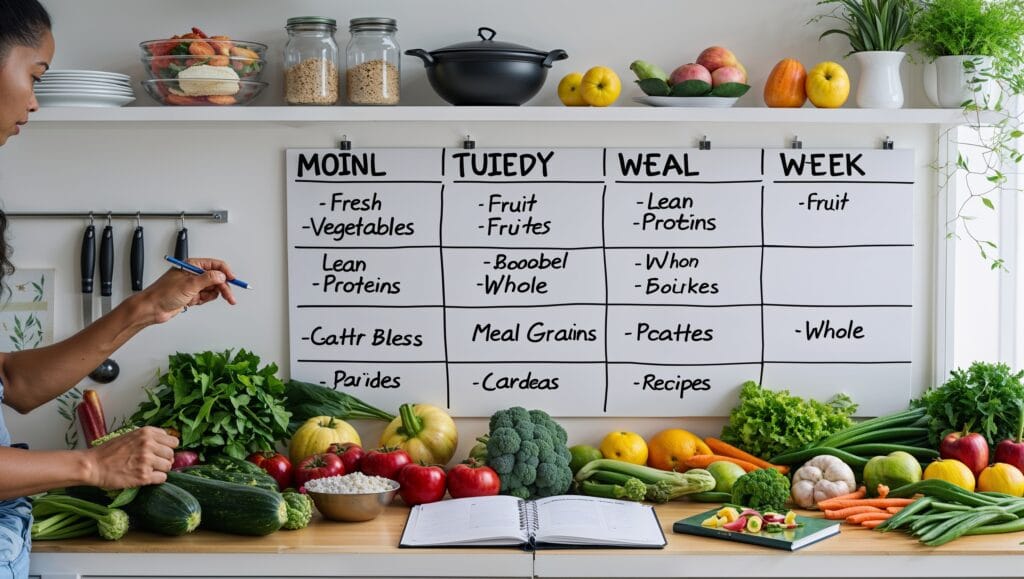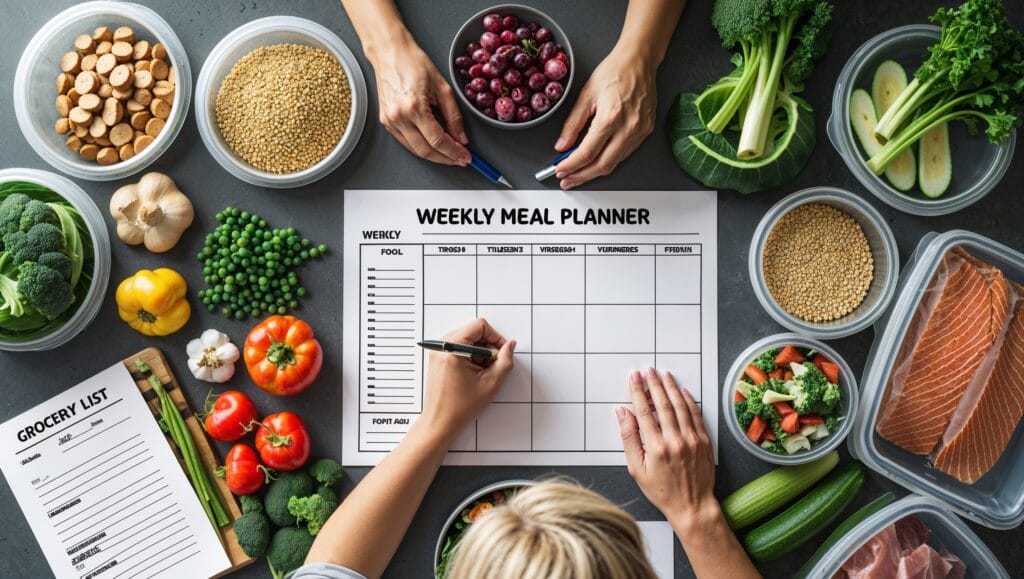Introduction
In today’s fast-paced world, maintaining a healthy diet can feel like a challenge. This is where healthy meal planning comes to the rescue. It’s a simple, effective way to ensure you’re eating well-balanced, nutritious meals without the hassle of daily decision-making. Whether your goal is weight management, saving money, or improving your overall health, healthy meal planning can make a significant difference.
This comprehensive guide breaks down everything you need to know about healthy meal planning, including its benefits, step-by-step instructions, and practical tips to keep you on track. By the end of this article, you’ll feel confident and prepared to take charge of your meals.
What is Healthy Meal Planning?

Healthy meal planning is the process of organizing your meals and snacks in advance, ensuring they are balanced, nutritious, and aligned with your dietary goals. It involves selecting wholesome ingredients, portioning meals appropriately, and preparing them for easy access throughout the week.
Meal planning is not just about convenience—it’s a powerful tool for promoting better nutrition and avoiding unhealthy eating habits. When done correctly, it can transform your relationship with food, reduce stress, and even save you money.
Why Is Healthy Meal Planning Important?

Healthy meal planning offers a wide range of benefits, including:
Improved Nutrition
By planning ahead, you can ensure each meal includes a variety of essential nutrients like vitamins, minerals, and fiber. It helps you avoid nutrient deficiencies and supports overall health.
Saves Time
Instead of scrambling to decide what to eat every day, meal planning allows you to prep your meals in one go. This streamlined approach frees up time for other activities.
Reduces Food Waste
When you buy only what you need, you’re less likely to let food go bad. Meal planning encourages mindful shopping and reduces the environmental impact of food waste.
Supports Fitness Goals
Whether you’re aiming for weight loss, muscle building, or improved endurance, meal planning helps you stick to your calorie and macronutrient targets.
Saves Money
Cooking at home is more cost-effective than dining out or ordering takeout. Planning meals also prevents impulse purchases at the grocery store.
10 Simple Steps for Healthy Meal Planning

If you’re new to meal planning or want to refine your process, these 10 steps will set you up for success:
Set Clear Goals
Start by identifying your objectives. Are you trying to eat healthier, lose weight, or save time? Defining your goals will guide your meal planning efforts and keep you motivated.
Assess Your Current Diet
Take a week to track what you’re currently eating. This will help you identify areas for improvement, such as eating more vegetables, reducing sugar intake, or increasing protein.
Plan Your Meals for the Week
Use a calendar or a meal planning app to organize your meals. Aim for a balance of macronutrients (proteins, carbs, and fats) and include plenty of fruits and vegetables.
Example:
- Breakfast: Scrambled eggs with spinach and whole-grain toast.
- Lunch: Grilled chicken salad with a variety of vegetables and a vinaigrette.
- Dinner: Baked salmon with quinoa and steamed broccoli.
Create a Grocery List
List all the ingredients you’ll need for the week. Stick to your list while shopping to avoid unnecessary purchases. Organize the list by sections, such as produce, proteins, and pantry staples.
Prep Ingredients in Advance
Spend an hour or two chopping vegetables, marinating proteins, and portioning snacks. This prep work will make cooking during the week faster and easier.
Pro Tip:
Use airtight containers or resealable bags to keep prepped ingredients fresh. Label each container with the meal and date.
Cook in Batches
Batch cooking is a time-saving strategy where you prepare large quantities of food at once. For example, roast a tray of vegetables or cook a pot of rice that can be used in multiple meals.
Use Proper Storage
Invest in high-quality, leak-proof containers to store your meals. Glass containers with compartments are great for separating different food items.
Incorporate Variety
Avoid getting bored with your meals by experimenting with new recipes, spices, and ingredients. Rotate your favorite meals weekly to keep things interesting.
Ideas for Variety:
- Swap chicken for turkey or tofu.
- Use different grains, like farro or barley, instead of rice.
- Experiment with international cuisines, such as Thai or Mediterranean.
Monitor Portion Sizes
Accurate portioning is crucial, especially if you’re managing your calorie intake. Use measuring cups, a food scale, or portion control containers to ensure consistency.
Stay Flexible
Life is unpredictable, and that’s okay! Keep a few quick and healthy options, like frozen vegetables, pre-cooked proteins, or canned beans, on hand for busy days.
Tips for Balanced Meal Planning
Creating balanced meals ensures you’re getting the right mix of nutrients. Here are some tips to achieve that:
- Include All Food Groups: Incorporate lean proteins, whole grains, healthy fats, and colorful vegetables.
- Limit Processed Foods: Focus on fresh, whole ingredients for better nutrition.
- Mind Dietary Preferences: Take allergies, intolerances, or cultural preferences into account when planning meals.
Sample Healthy Meal Plan
Here’s an example of a balanced weekly meal plan to inspire your meal planning process:
| Day | Breakfast | Lunch | Dinner | Snacks |
|---|---|---|---|---|
| Monday | Oatmeal with almond butter | Grilled chicken and quinoa salad | Stir-fried tofu with vegetables | Greek yogurt with berries |
| Tuesday | Smoothie with spinach and banana | Turkey wrap with avocado | Baked salmon with roasted carrots | A handful of mixed nuts |
| Wednesday | Scrambled eggs and toast | Lentil soup with a side salad | Grilled shrimp with brown rice | Hummus with cucumber sticks |
| Thursday | Greek yogurt with granola | Chicken and vegetable stir-fry | Spaghetti squash with marinara | A piece of fruit |
| Friday | Whole-grain pancakes | Tuna salad with crackers | Grilled steak with sweet potato | Dark chocolate and almonds |
Common Mistakes to Avoid
While meal planning is straightforward, there are a few pitfalls to watch out for:
Overcomplicating Recipes
Stick to simple, easy-to-make dishes, especially when starting out.
Forgetting Snacks
Include healthy snacks in your plan to avoid reaching for junk food.
Ignoring Portion Sizes
Even healthy foods can lead to weight gain if portion sizes are too large.
Skipping Meal Prep
Failing to prep ahead of time can derail your plans and lead to takeout temptations.
FAQs About Healthy Meal Planning
- What are the benefits of healthy meal planning?
- Healthy meal planning improves nutrition, saves time, reduces food waste, and helps you stay on track with fitness or wellness goals.Add Image
- How do I meal plan on a budget?
- Buy seasonal produce, shop in bulk, and plan meals using affordable staples like beans, rice, and frozen vegetables.Add Image
- How do I avoid boredom with meal planning?
- Incorporate new recipes, use different spices, and rotate your meals weekly. Trying cuisines from around the world can also keep things exciting.Add Image
- What are the best meal prep containers?
- Look for BPA-free, leak-proof containers with compartments. Glass containers are durable and microwave-safe.Add Image
- How long do prepped meals last in the fridge?
- Most prepped meals last 3-5 days in the fridge when stored in airtight containers.Add Image
- Can I meal prep for a family?
- Yes! Meal planning for a family involves scaling recipes and incorporating dishes that everyone enjoys. Consider making family-sized portions and storing them in larger containers.
Conclusion

Healthy meal planning doesn’t have to be complicated. By following these simple steps, you can save time, eat nutritious meals, and stay on track with your health goals. Whether you’re prepping meals for the week or just looking for inspiration, small changes can make a big impact.
For more meal-planning guidance, check out these helpful resources:
- MyPlate – USDA’s Guide to Healthy Eating
- Harvard’s Healthy Eating Plate
- American Heart Association Meal Planning Tips
By using these tools and strategies, you can make meal planning an enjoyable and sustainable habit. Happy cooking!
- The Ultimate Banana Pancake Recipe: 6 Simple Steps for a Healthy Start
- Blue Cheese Dressing Recipe: 7 Easy Steps to Creamy Perfection
- 5 Best Cheese Sauce Recipes for Every Meal
- 10 Secrets to Homemade Spaghetti Sauce: The Ultimate Guide to Perfection
- 10 Secrets to Master the Art of Spaghetti Sauce Recipe: Easy, Homemade Guide



